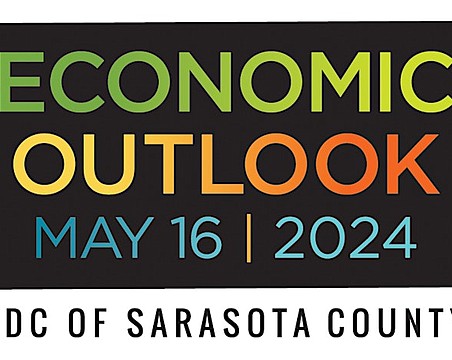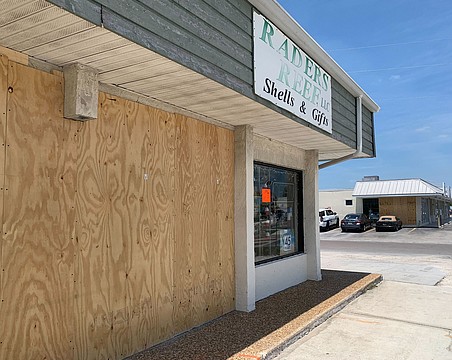'We're Having Fun'
Sarasota's SunCoast Bank learned the disadvantages of being nationally chartered. In 2004, it expects to make up lost ground.
By Matt Walsh
Editor
When John Stafford and William Gnerre began organizing Sarasota-based SunCoast National Bank in late 1998, they knew their timing was right.
Like Gen. Sherman rolling through Atlanta, the interstate regional banks had completed their march through Florida, swallowing bank after bank until there were no banks of any sizable consequence to be acquired and conquered. In their aftermaths, NationsBank, First Union, SunTrust, SouthTrust, Wachovia, AmSouth, RegionsBank left the perception that their interest lay only in consumer market share. Small-business customers, it seemed, were merely numerical accounts in a database that could be trained to use "1-800-BANK."
In Sarasota, this atmosphere especially manifested itself in the wake of NationsBank's January 1998 acquisition of Florida's one and only home-based big bank - Barnett Bank. Tired of changing bank names on their checking accounts, Barnett's small-business customers became anxious to find bankers whose business cards stayed valid for more than six months and who would treat their customers with Ritz-Carlton service.
"There was a huge vacuum for a new community bank," says Gnerre, whose first banking job in Sarasota came in 1978 with the now-defunct Southeast Bank. Indeed, from then until 1997, Gnerre and Stafford worked as a senior executives at three banks, each of which was acquired by a bigger regional powerhouse.
At one point, in the early 1990s, after NationsBank had acquired Citizens & Southern, where Stafford was president of its Sarasota operations, recruiters persuaded them to go to Douglasville, Ga., to turn around a suburban Atlanta bank that regulators were on the verge of shutting. They spent three years bringing it back to health, only to have it acquired by RegionsBank in 1997. When that happened, Gnerre recalls, "We said, 'Let's go back home.' "
That's when Stafford and Gnerre decided to form SunCoast National Bank. Stafford would be president and chief executive officer, and Gnerre would serve as executive vice president and chief operating officer.
"Our goal was to have the premier community bank in Sarasota," Gnerre says. And with their 17 years of banking experience and making connections in Sarasota, they tried to and succeeded in assembling six other directors and investors who had long tentacles in Sarasota's business community.
At the top of the list was H.R. "Ron" Foxworthy, a longtime Sarasota plumbing contractor and real estate investor, former director of Ellis Bank (NCNB's first Florida acquisition) and, perhaps most important, a director of FCCI Insurance Group, one of the most influential companies in the region. Along with Foxworthy, Stafford (also an FCCI director) and Gnerre, brought in Dr. Henry Black, owner of the Cardiovascular Health Institute of Sarasota; Dr. Stanley A. Williams, a retired Sarasota dentist; Roy Yahraus, owner of Gulf Coast Building Materials; James Rutledge, another Sarasota real estate investor; and Larry Berberich, retired owner of an aerospace company.
Altogether, if you were filling in the blanks on the ingredients of a successful community bank and its board of directors, SunCoast had all of them.
But as SunCoast Bank approaches its fifth anniversary, its financial results so far have cast it in the bottom tier when compared to its Sarasota peers in the Classes of '99 and '00 community bank startups. To wit:
× At $69.5 million in assets at the end of September, SunCoast's average annual asset growth has been the slowest of the group - 40%. By comparison, Bank of Commerce, which started a year after SunCoast, has shown average annual asset growth three times faster.
× It has taken SunCoast four years to reach profitability while most of its Sarasota peers took three years to reach that milestone. SunCoast has generated $1.73 million in losses through Sept. 30 (the most recent FDIC data available) since its inception - more than twice the amount of losses of each of its other Sarasota classmates (Bank of Commerce, Landmark Bank and People's Community Bank). The only Sarasota-Manatee County startup that has lost more money is Coast Bank of Florida - $4.2 million.
× With these losses and the slowest asset growth, SunCoast in turn ranks in the bottom tier on two key banking yardsticks - return on assets and return on equity. Among the Sarasota County-based startups, SunCoast has generated the lowest ROA (0.2%) and ROE (2.29%). Strong-performing banks typically generate 1% ROA and at least 10% ROE, although it should be noted that startup banks seldom, if ever, reach those levels in their first five years of operation.
× And when SunCoast is measured against its peers in terms of efficiency, it is noticeably less efficient. It costs SunCoast Bank 84 cents to generate $1 in interest income on the loans it makes. At Bank of Commerce, it costs 69 cents to generate $1 of income. And at Sarasota Bank, recently acquired by Colonial Bank and often considered a high-performing bank, it costs only 47 cents to generate $1 of interest income.
Do all of these indicators mean SunCoast Bank is what regulators call a "troubled bank"? Far from it. SunCoast has among the highest levels of capital (greater than 10%) among its peers and well above regulatory requirements. What's more, the bank's loan portfolio is nearly pristine. Noncurrent loans - borrowers who are more than 60 days behind on their payments - are only 0.6% of total loans. Dead assets - loans that are virtually lost causes - total only 0.4% of total assets. These two ratios are well within levels of startup banks.
Then why is SunCoast in the lower tier of its classmates? Will it move up in the ranks? How long will it take?
As in all businesses, the answers lie in strategy and execution.
SunCoast's higher cost structure and slower asset growth compared to its peers can be attributed to two decisions the bank's organizers made: to start up as an over-the-counter publicly traded stock and as a nationally chartered bank.
Typically, startup banks organize as state-chartered, privately held companies, with the idea of going public much later. They pursue this course, in part, to avoid the associated costs and regulatory burdens of filing with the Securities and Exchange Commission - on top of the already mountainous regulatory costs imposed by state and federal bank regulators. What's more, a startup bank's public stock isn't likely to look attractive in the early years, perhaps giving the public markets an unfavorable - albeit undeserved - view of the company. Indeed, a startup bank's stock often is considered highly illiquid for the first five years.
But SunCoast's directors thought going public and being nationally chartered would give the bank advantages. Gnerre acknowledges that being public adds reporting costs to SunCoast, but he says the costs are not material. Plus, he notes, the underwriting costs are now behind SunCoast. When other banks in the Classes of '99 and 2000 go public, as they grow larger, they'll face higher initial public offering costs than they otherwise might have when they were small.
Gnerre says SunCoast chose to organize as a nationally chartered bank in part because that's what he and Stafford were accustomed. "We had a comfort level with the examiners," Gnerre says. "We felt they were the most experienced and knowledgeable examiners." Stafford and Gnerre believed the "national" designation would signal to customers a more solid and prestigious image, that SunCoast would be operating under higher standards than a state-chartered bank.
Going public from the outset would be even more advantageous, or so SunCoast's directors thought. As the bank was organizing, consultants advised them that being a publicly traded bank would help them raise capital faster to get started. More important, being listed as a nationally chartered bank on the over-the-counter market immediately would create more liquidity for shareholders.
So when SunCoast opened in September 1999, the initial public offering of 700,000 shares at $10 a share generated $7 million in capital. At the close of last week, SunCoast's shares were trading at $9 a share - $1.52 a share less the bank's book value. (In comparison, Bank of America stock recently was trading at 2.3 times greater than book value.)
As it turned out, the national charter and going public has had its disadvantages.
The biggest most costly disadvantage has come in SunCoast's lending capabilities. Federal bank regulations limit the size of individual loans to no more than 15% of a bank's capital. State-chartered banks, however, can lend up to 25% of capital. This put SunCoast at a competitive disadvantage that, frankly, caught Stafford and Gnerre by surprise.
When they organized the bank, they figured their small-business loans would average out at between $400,000 and $500,000 per transaction. What's more, they wanted to emphasize credit quality - good loans as opposed to big loans. "We said we were going to be very conservative. We wanted to spread our risk and keep our loan size down. We learned from experience that one bad, big loan could take you down."
But once they began competing for sales, Stafford and Gnerre discovered to their surprise that Sarasota's banking market had changed dramatically during their three years in Georgia. Because of rising real estate values, the average loan size doubled - to $1 million and $1.2 million. SunCoast, however, could lend only up to a maximum of about $800,000, thanks to its nationally chartered limitations.
To compensate for being unable to compete for many assets, Stafford and Gnerre formed lending alliances with other banks, sharing the underwriting on some of the larger loans. Still, Stafford and Gnerre realized they needed to make a change. In August 2002, SunCoast filed with the Florida comptroller to convert from a nationally chartered bank to a state-chartered bank. A year ago, it received the approval, giving SunCoast a loan limit that is now 25% of capital, or up to about $1.7 million on a loan.
SunCoast's public-company status has had an unintended consequence as well. While being public makes it easier to tap a wider investing network for expansion capital, SunCoast's board confronted a dilemma in September when it decided to raise an additional $2.25 million for growth: A common stock offering, at say $9 a share, could dilute the value of existing common shares by 25% and send an unpleasant signal to public investors.
To avoid the dilution, SunCoast raised the new capital in a private placement offering of 225,400 shares of convertible preferred stock. The preferred stock now obligates SunCoast to pay dividends totaling $13,500 on Sept. 30, 2004 and 2005 (6 cents per preferred share). Or, the preferred holders can convert those shares to common stock at a price of $8.50 a share on those two dates. In effect, SunCoast has postponed the date of dilution.
The strategy should be clear: By the time the dividends or conversions are to occur, SunCoast's directors are banking on the company's earnings to be stronger and its book value rising - both of which would appease any dilution to common shareholders.
But to generate greater profits, here's where SunCoast's execution comes in. Stafford, Gnerre and the bank's directors know that greater profits come from cutting and controlling expenses and increasing sales. With its payroll already the lowest as a percentage of non-interest expense, Stafford and Gnerre know that SunCoast needs more and bigger loans. Which require more sales and more successful salesmanship.
Easier said than done. Increased sales come from either taking business away from a competitor; winning a greater share of the growth in the market; increasing the sales staff's success rate; hiring more sales people; or a combination of each. "Counting on the growth in the marketplace is a losing proposition," Gnerre says. "You basically have to steal business in this town."
Gnerre says SunCoast's strategy is to "field the best bankers" in the market. The bank, for instance, likes to promote that its executives - Stafford, Gnerre and its two top lenders, John Solum and Frank Guididas - have more than 100 years of combined lending experience in Sarasota and Manatee counties. SunCoast is hoping to add to that experience level early in 2004, too. Gnerre says the bank is looking for one to two more senior, experienced lenders who can bring with them a book of customers; it's also looking for a third branch site (the headquarters is in Palmer Ranch and it has an office at 17th Street and Honore in Sarasota).
Of course, adding all this would adversely affect the bank's expense level. "Our board understands that," Gnerre says. "We told everyone when we were organizing that we had a five-year plan and not to expect to see a big return for at least five to seven years."
Gnerre says Stafford and he are confident that from here on SunCoast's asset size and growth rate will pick up velocity while its expense ratios will fall. "We would have liked to have been larger faster," he says. "But we expect to break through $100 million in assets real soon. We also think we have the team in place now that can be leveraged out without increasing expenses. Over time we'll be extremely efficient."
Is SunCoast a candidate to merge or be bought?
"We're in no rush for that," says Gnerre.
The likelihood is not high, either. It's too small to attract a premium price or the attention of bigger acquiring banks. "They want to make an immediate impact," Gnerre says. Besides, there's no unrest on the board, which controls 36% of the common stock.
"Our group is enjoying our independence," Gnerre says. "We've been profitable for five quarters. We have new capital. We're having fun."
HOW SARASOTA, MANATEE'S CLASSES OF 1999, 2000 COMPARE
(Dollars in thousands, as of Sept. 30, 2003)
Coast BankBk of CommerceLandmarkPeople's FlagshipHorizonSuncoast
Year founded2000200020001999199919991999
Operating Income
1999-$708-$652-$460-$657
2000-$1,988-$1,063-$494-521-790-705-702
2001-922-874-300-121-602-679-535
2002-1,260436412125252129-55
YTD 2003-96716419453287263219
Cumulative earnings-4,266-78537-772-1,505-1,452-1,730
Assets
1999$13,993$21,073$6,829$16,004
200055,20015,95026,51971,14742,35527,65824,351
2001112,70058,12049,37464,39661,73455,53141,146
2002175,865102,05279,09282,77083,52773,06960,309
YTD 2003224,650134,547108,083105,25491,53283,99869,507
Average annual growth62%123%60%113%47%112%40%
RETURN ON ASSETS
1999----3-4.35-6.74-5.62
2000-3.05-4.68-1.47-0.75-2.51-4.26-3.78
2001-0.6-1.47-0.460.03-1.1-1.5-1.56
2002-0.490.320.410.10.540.23-0.03
YTD 200300.490.510.390.440.450.2
RETURN ON EQUITY
1999----9.14-9.89-9.54-12.08
2000-23-8.15-5.28-6.34-12.33-15.87-14.19
2001-6.5-6.82-3.090.29-9.78-13.88-11.44
2002-4.92.893.821.086.933.45-0.36
YTD 20030.014.75.494.696.226.682.29
NET Capital infusions
1999$6,000$7,545$5,280$6,000
20006,0009,0596,5001,056
20015,7479401,000*
20026,9114,0002,46902,170
200322,0001,4001,000*
Total40,65813,0598,9699,3968,170
Key Ratios
Equity capital to assets 7.13%9.33%8.49%8.23%9.05%6.9710.48
Core capital (leverage) ratio 6.75%9.97%8.73%8.42%9.3%7.2110.15
Tier 1 risk-based capital ratio 9.05%11.42%10.19%9.48%13.56%9.0911.57
Total risk-based capital ratio 10.06%12.67%11.22%10.56%14.63%10.0612.55
Interest deposits/total deposits88%94%88%88%89%91%90%
Nonint. Expense/Earning assets4.47%2.66%3%3.45%2.62%3.89%3.03%
Yield on earning assets6.25%5.97%5.83%5.99%5.55%7.11%5.66%
Efficiency ratio93.73%66%75%75%75%80%83%
Net interest margin3.23%3.84%3.78%3.98%3.16%4.33%3.58%
*From parent holding company. Source: FDIC





